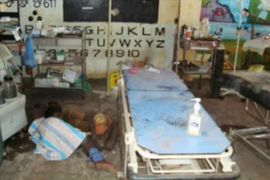Sri Lanka denies shelling hospital
Military accused of killing 67 civilians in northern conflict zone.

“They must take the full responsibility for the people who were killed or injured.”
‘Shell attacks’
Dr Thurairajah Varatharajah, a medical official working at the hospital, told Al Jazeera the hospital had also been hit the day before.
| In depth | ||||||||

|
“Yesterday there were shell attacks on the hospital … and today there were two attacks, mainly in front of the hospital and other places as well,” he said.
“Today, shells fell on the hospital area, totalling 60 to 70 persons dead; 87 persons got injured.
“Most of these people already had injuries and were staying in the hospital.”
Varatharajah said that people were still arriving for treatment, but supplies were low and some hospital staff had left.
It is impossible to independently verify reports from the army or LTTE due to journalists and international organisations being barred from the conflict zone.
UN claims
The alleged incident came a day after the UN released satellite imagery purportedly showing security forces shelling a civilian area.
The images showed craters which were formed inside the war zone between February 15 and April 19, the day before the army breached LTTE defences and civilians started to pour out.
| Focus: Sri Lanka | ||||||||

|
“The imagery is fairly clear and shows the time, so anybody can study and compare them,” Einer Bjorge, the head of the mapping unit at Unosat (the United Nations Operational Satellite Applications Programme), told Al Jazeera.
He said the pattern of the craters would have required air power.
The defence ministry said the allegations had “no scientific viability”.
Sri Lanka’s president also said that no heavy weapons were being used against the LTTE.
“If you are not willing to accept the fact that we are not using heavy weapons, I really can’t help it,” Mahinda Rajapaksa, the Sri Lankan president, said.
“We are not using heavy weapons. When we say ‘no’, it means ‘no’. If we say we are doing something, we do it. We do exactly what we say, without confusion,” he said.
Rajapaksa said that the military is doing all it can to prevent civilian casualties.
Military attack
The government said on Saturday that they had killed 14 LTTE fighters in the latest battles.
The military also released video footage of navy patrol boats attacking what it said were LTTE vessels.
 |
| Some sources say the hospital was shelled on both Friday and Saturday [TamilNet] |
The Tamil United Liberation Front (TULF), a pro-government party, called for Rajapakse to name an international agency to which LTTE fighters can hand over their weapons in exchange for an amnesty.
The idea was proposed as a way to safeguard bystanders in the conflict area.
Up to 50,000 civilians are believed to be trapped in the 5km-long coastal war zone, according to the UN, although the government says the figure is about 20,000.
International pressure on the government has grown recently to enforce a ceasefire to ensure the safety of the civilians trapped in the region.
Both the French and British foreign ministers on Wednesday asserted the need for a truce.
Gordon Weiss, a UN spokesman for Sri Lanka, said that there were at present two crises in the region – those people trapped in the conflict zone and the refugee camps in the north of the country.
“The population that emerged in the last 10 days was emaciated, worn down, bearing large numbers of war injured. Medical facilities in the area are still struggling to cope with the sheer number of people who have emerged,” he said.
The LTTE have been fighting a 23-year secessionist war against the government for a homeland in the northeast for the ethnic-minority Tamils.
